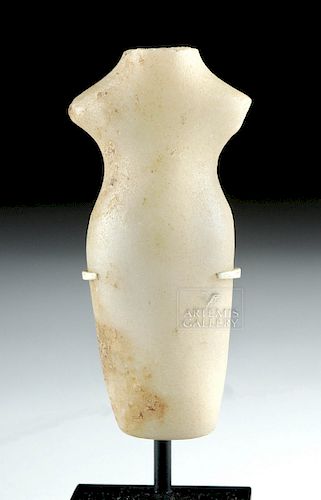Anatolian Marble Figural Idol
Lot 106b
About Seller
Artemis Gallery
686 S Taylor Ave, Ste 106
Louisville, CO 80027
United States
Selling antiquities, ancient and ethnographic art online since 1993, Artemis Gallery specializes in Classical Antiquities (Egyptian, Greek, Roman, Near Eastern), Asian, Pre-Columbian, African / Tribal / Oceanographic art. Our extensive inventory includes pottery, stone, metal, wood, glass and textil...Read more
Estimate:
$2,800 - $4,200
Absentee vs Live bid
Two ways to bid:
- Leave a max absentee bid and the platform will bid on your behalf up to your maximum bid during the live auction.
- Bid live during the auction and your bids will be submitted real-time to the auctioneer.
Bid Increments
| Price | Bid Increment |
|---|---|
| $0 | $25 |
| $300 | $50 |
| $1,000 | $100 |
| $2,000 | $250 |
| $5,000 | $500 |
| $10,000 | $1,000 |
| $20,000 | $2,500 |
| $50,000 | $5,000 |
| $100,000 | $10,000 |
| $200,000 | $20,000 |
About Auction
By Artemis Gallery
Jun 20, 2019
Set Reminder
2019-06-20 10:00:00
2019-06-20 10:00:00
America/New_York
Bidsquare
Bidsquare : Ancient / Ethnographic From Around the World
https://www.bidsquare.com/auctions/artemis-gallery/ancient-ethnographic-from-around-the-world-4217
Around the world & back in time - be amazed at the treasures you will find. Antiquities from Egypt, Greece, Italy and the Near East, Asian, Pre-Columbian, African / Tribal / Oceanic, Native American, Spanish Colonial, Russian Icons, Fine Art, much more! All categories, all price ranges.. all legal Artemis Gallery info@artemisgallery.com
Around the world & back in time - be amazed at the treasures you will find. Antiquities from Egypt, Greece, Italy and the Near East, Asian, Pre-Columbian, African / Tribal / Oceanic, Native American, Spanish Colonial, Russian Icons, Fine Art, much more! All categories, all price ranges.. all legal Artemis Gallery info@artemisgallery.com
- Lot Description
Ancient Near East, Anatolia, early Bronze Age II-III, ca. 2700 to 2000 BCE. A finely-sculpted standing anthropomorphic idol of a characteristically abstract form. The figure has a rounded, tapered base which gradually expands to slender feminine hips, a lightly-corseted waist line, a smooth chest with a pair of conical arms, and a circular neck. When first formed, this figure would have boasted a minimalist head which likely bore no discernible facial features. The meaning and function of such idols remains an enigma without any written records from this era. Archaeologists have theorized that since fertility was prized by these ancient peoples, idols like this example perhaps took inspiration from the female anatomy, albeit in an abstract, uncomplicated manner which appeals to the modern taste for minimalism. Custom museum-quality display stand included. Size: 1" W x 2.625" H (2.5 cm x 6.7 cm); 3.3" H (8.4 cm) on included custom stand.
Scholars do not known for certain the meaning and purpose of these idols. However, it has been suggested that these figures were associated with motherhood and fertility. Votive idols like this one are known in a variety of fascinating forms throughout the pre-literate ancient world. From the truly abstract Kilia-type figures that are barely recognizable as human to the exaggerated feminine shapes of so-called "Venus" figures, people in the past, as today, had a clear desire to portray human forms and did not feel constrained by naturalism.
Provenance: private East Coast, USA collection, acquired at Arte Primitivo Gallery, New York, New York, USA; ex-Richard Wagner collection, Cape Cod, Massachusetts, USA, acquired in the 1960s
All items legal to buy/sell under U.S. Statute covering cultural patrimony Code 2600, CHAPTER 14, and are guaranteed to be as described or your money back.
A Certificate of Authenticity will accompany all winning bids.
We ship worldwide and handle all shipping in-house for your convenience.
#143621Original head missing. Small chips to neck line and one arm, with light yellowing to natural marble coloration, and light encrustations. Light earthen deposits throughout.Condition
- Shipping Info
-
All shipping is handled in-house for your convenience. Your invoice from Artemis Gallery will include shipping calculation instructions. If in doubt, please inquire BEFORE bidding for estimated shipping costs for individual items.
-
- Buyer's Premium



 EUR
EUR CAD
CAD AUD
AUD GBP
GBP MXN
MXN HKD
HKD CNY
CNY MYR
MYR SEK
SEK SGD
SGD CHF
CHF THB
THB














